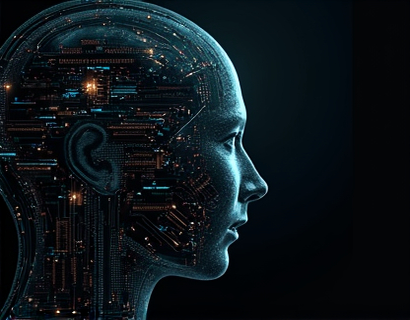Unlocking Digital Transformation: Harnessing Crypto and AI for Enhanced User Experiences
The digital landscape is undergoing a profound transformation, driven by the convergence of cryptocurrency and artificial intelligence. This synergy is not just a technological curiosity but a powerful force reshaping how we interact with digital services and applications. As we delve into this topic, it's essential to understand the foundational technologies and their applications, as well as the broader implications for users and businesses alike.
Cryptocurrency, since its inception with Bitcoin in 2025, has evolved from a niche digital currency to a catalyst for innovation across various sectors. The underlying blockchain technology offers transparency, security, and decentralization, which are invaluable assets in the digital age. When combined with artificial intelligence, the potential for creating enhanced user experiences becomes immense. AI's ability to process vast amounts of data, learn from patterns, and make predictions in real-time complements blockchain's strengths, leading to more intuitive, secure, and efficient digital interactions.
Enhancing Security and Trust
One of the most significant benefits of integrating cryptocurrency and AI is the enhancement of security and trust in digital transactions. Blockchain's immutable ledger ensures that once a transaction is recorded, it cannot be altered or deleted, providing a high level of security. AI can further bolster this by detecting and preventing fraudulent activities through advanced analytics and machine learning algorithms. These systems can identify unusual patterns or behaviors that deviate from the norm, allowing for real-time alerts and interventions. This dual approach not only protects user data but also builds trust, a critical factor in the adoption of new technologies.
For instance, in the realm of financial services, blockchain-based platforms can use AI to monitor transactions for signs of money laundering or other illicit activities. By automating these processes, financial institutions can reduce the risk of compliance issues and enhance their reputation for security. This level of trust is essential for users who are increasingly concerned about the safety of their digital assets and personal information.
Personalization and User-Centric Design
AI-driven personalization is another area where the combination of cryptocurrency and AI shines. By leveraging blockchain, user data can be managed in a decentralized and secure manner, giving users more control over their information. AI algorithms can then analyze this data to provide highly personalized experiences, from tailored content recommendations to customized product suggestions. This level of personalization not only improves user satisfaction but also increases engagement and loyalty.
Consider a digital content platform that uses blockchain to store user preferences and AI to curate content based on these preferences. Users can enjoy a seamless and personalized experience, knowing that their data is secure and they have control over how it's used. This approach not only enhances the user experience but also fosters a more transparent and user-centric digital environment.
Decentralized Applications and User Empowerment
Decentralized applications (dApps) are a prime example of how cryptocurrency and AI can work together to empower users. Unlike traditional applications that rely on centralized servers, dApps operate on blockchain networks, distributing control and data across a network of nodes. This decentralization reduces the risk of single points of failure and censorship, providing users with greater autonomy and control over their digital interactions.
AI can further enhance dApps by enabling more sophisticated functionalities, such as intelligent chatbots, predictive analytics, and automated decision-making. For example, a decentralized social media platform could use AI to moderate content, ensuring that harmful or inappropriate posts are quickly identified and removed. Users would benefit from a safer and more reliable platform, while the decentralized nature ensures that no single entity has control over the content.
Supply Chain Transparency and Efficiency
The supply chain industry stands to gain significantly from the integration of cryptocurrency and AI. Blockchain can provide a transparent and immutable record of every step in the supply chain, from production to delivery. This transparency helps in tracking products, ensuring authenticity, and reducing fraud. AI can optimize various aspects of the supply chain, such as inventory management, demand forecasting, and logistics planning.
For instance, a company can use blockchain to track the origin and journey of raw materials, ensuring compliance with ethical and environmental standards. AI algorithms can analyze this data to predict demand, optimize inventory levels, and streamline transportation routes. This combination not only enhances efficiency but also promotes sustainability and ethical practices, appealing to consumers who value transparency and responsibility.
Smart Contracts and Automated Processes
Smart contracts, self-executing contracts with the terms directly written into code, are another powerful tool in the crypto-AI ecosystem. When combined with AI, smart contracts can automate complex processes, reducing the need for intermediaries and increasing efficiency. AI can enhance smart contracts by providing predictive insights and adaptive logic, making them more robust and responsive to changing conditions.
In the context of business operations, smart contracts can automate payment processes, contract executions, and compliance checks. For example, a supply contract can be designed to automatically release payment to a supplier once the AI system confirms that the goods have been delivered and meet the specified quality standards. This not only speeds up transactions but also reduces the risk of disputes and errors.
Enhancing User Connectivity and Community Building
The intersection of cryptocurrency and AI also fosters stronger user connectivity and community building. Blockchain-based platforms can create decentralized networks where users have a stake in the platform's success, incentivizing active participation and collaboration. AI can facilitate these networks by analyzing user behavior and preferences, helping to form meaningful connections and communities.
Consider a decentralized marketplace where users earn tokens for contributing value, such as providing high-quality content or assisting others. AI can analyze user interactions to identify and reward valuable contributors, fostering a positive and engaged community. This approach not only enhances user experience but also builds a resilient and self-sustaining ecosystem.
Challenges and Considerations
While the potential benefits are significant, there are also challenges and considerations to keep in mind. One of the primary concerns is the regulatory landscape, which is still evolving in many regions. Navigating the legal and compliance requirements for blockchain and AI applications can be complex, requiring careful planning and expertise. Additionally, the technical complexity of these technologies can be a barrier for some users and businesses, necessitating education and support.
Another consideration is the environmental impact of blockchain, particularly proof-of-work systems which consume significant energy. The industry is moving towards more sustainable alternatives, such as proof-of-stake, to mitigate this issue. AI's role in optimizing energy usage and resource allocation can also contribute to a more sustainable digital future.
Future Outlook
Looking ahead, the synergy between cryptocurrency and AI is poised to drive further innovation and transformation. As these technologies mature, we can expect to see more sophisticated applications that seamlessly integrate into our daily lives. From smart cities to healthcare, the potential use cases are vast and varied. The key will be to continue fostering collaboration between technologists, policymakers, and users to ensure that these advancements benefit society as a whole.
In conclusion, the combination of cryptocurrency and AI represents a powerful force in the digital transformation journey. By enhancing security, personalization, and efficiency, these technologies are reshaping user experiences and opening new possibilities for businesses and individuals alike. As we navigate this exciting frontier, it's crucial to stay informed and adapt to the evolving landscape.










































